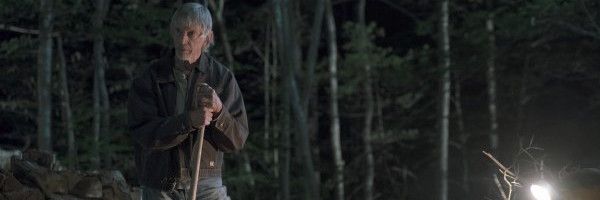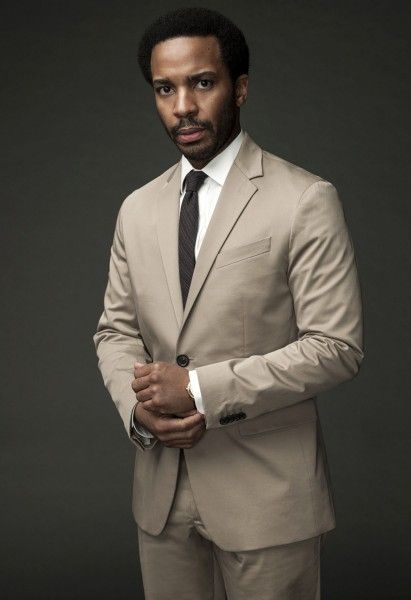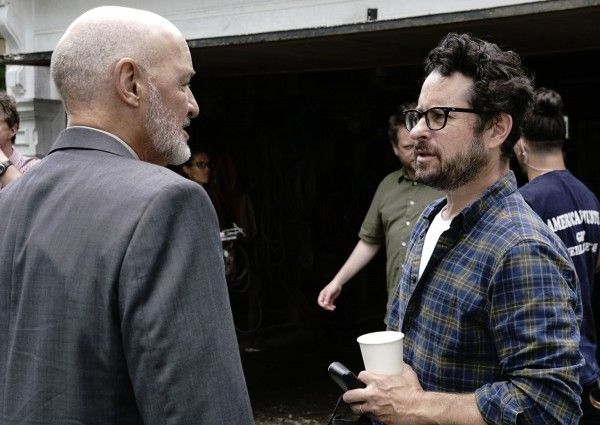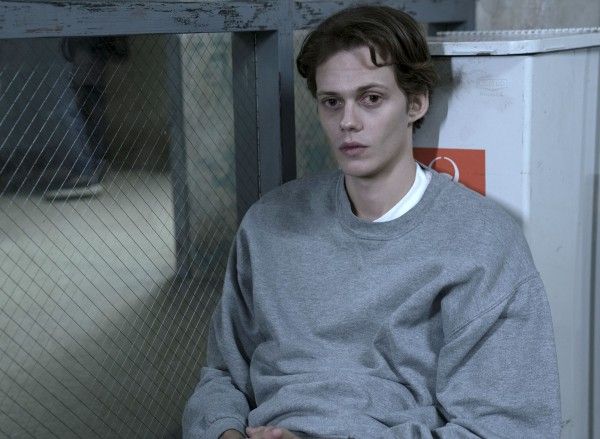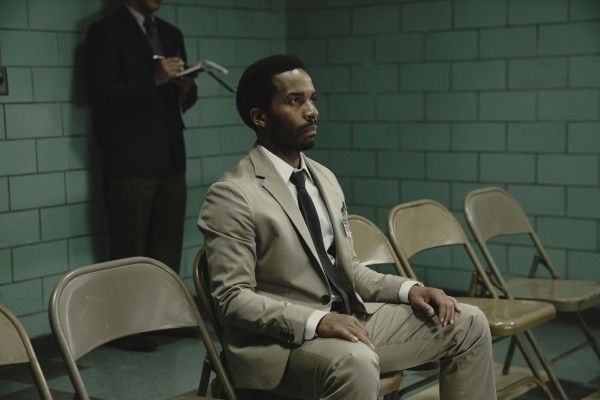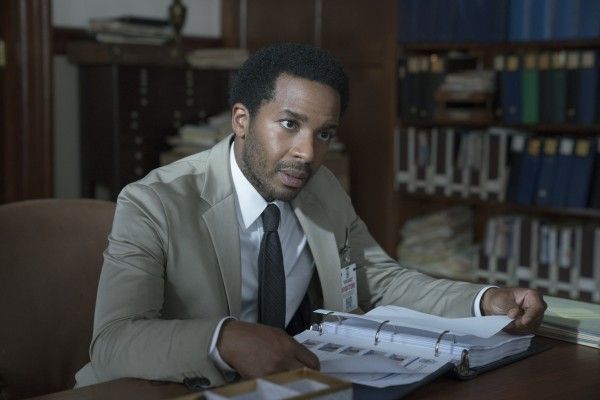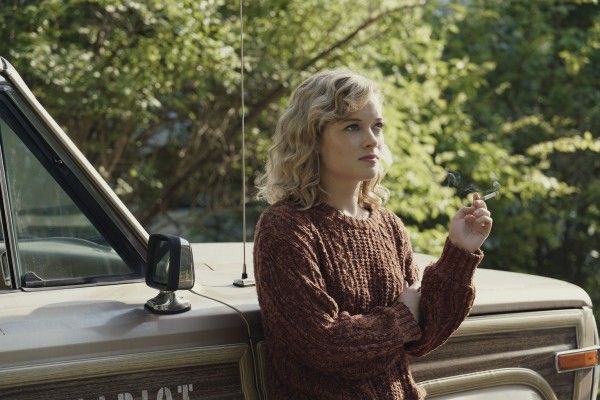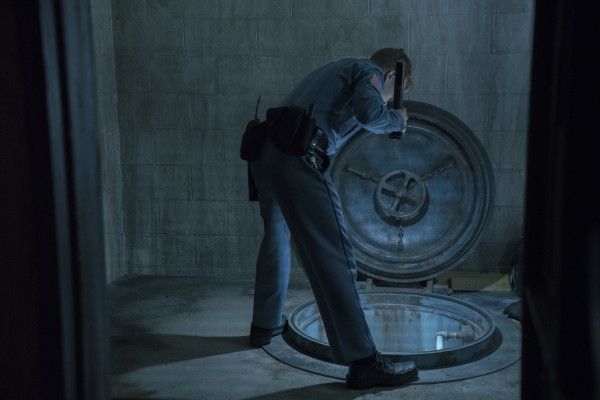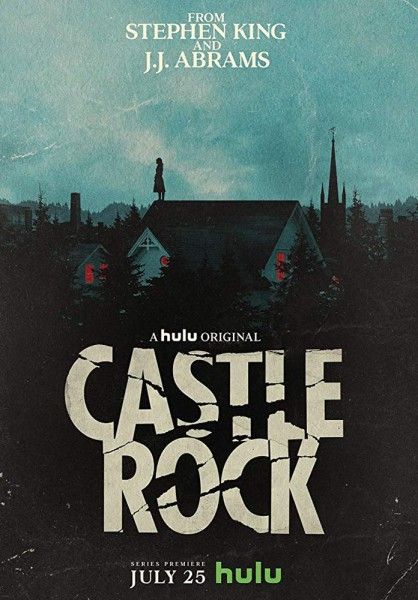From show co-creators Sam Shaw and Dustin Thomason and executive producer J.J. Abrams, the Hulu psychological-horror series Castle Rock is an original story set in the Stephen King multi-verse that mines his best-loved works and plays with themes of darkness and light, all while set in this small Maine town that is full of strange occurrences, mysteries and all manner of sin. Castle Rock is a place with a history that is clearly unsettling, and as its mysteries start to unravel, audiences will want to follow all of the twists and turns to its sure to be creepy conclusion. The series stars André Holland, Melanie Lynskey, Sissy Spacek, Bill Skarsgård, Jane Levy and Scott Glenn.
During this phone interview with Collider, showrunners Sam Shaw and Dustin Thomason talked about why it’s taken a decade for them to bring their idea for a show set in the world of Stephen King to life, how scary it was to wait to find out if they had Stephen King’s approval on the project, condensing thousands of pages into one season-long story, their seasonal anthology approach, Easter eggs, putting this incredible cast together, making the town a character, and how the season will only get more shocking and more mind-bending as it goes on.
Collider: I love this show! I’ve seen four episodes and I’m so excited to see more. I think you have the most ridiculously talented cast and they’re just so much fun to watch together.
DUSTIN THOMASON: We sometimes pinch ourselves when we look on the screen. It’s amazing!
SAM SHAW: They’re pretty unbelievable. It’s pretty great.
It seems like you’d want any one of these actors in whatever you might be doing, but having all of them together is just ridiculous.
SHAW: I know. I think there was a vision of what this show could have been – a World of Stephen King show that would have been like the Avengers of Stephen King, with Carrie and Red from Shawshank Redemption driving around in Christine, with Cujo sticking his head out of the back window. We did not opt for that version of this show, but we did form our own Avengers of casting. The only headache when you have a cast this incredible is that you want to be able to write for every one of them, in every scene, but most of the time, you have to be a little bit patient and leave an all-star player on the bench while you’re writing for somebody else.
You guys first kicked around the idea of doing a TV series set in Castle Rock a decade ago. Why didn’t it work out then, and why did it work out now?
THOMASON: A decade ago, we were both pretty fledgling television writers. Being able to work with this material was something that, as much as we started discussing the idea almost for fun, never seemed like a real possibility. People had actually approached Stephen King before about doing a world of Stephen King show. Honestly, I think J.J. [Abrams] was the missing link. The trust and mutual admiration society that they have was the thing that really allowed Steve to feel comfortable with somebody taking on the entirety of his 50 plus novels and trying to create a new story out of it. We didn’t know J.J. back then and we were just getting started, so it felt like a pipe dream. Finally, somehow the magical stars aligned, a little bit later.
How scary was it to try to get Stephen King’s approval on this?
SHAW: It was completely petrifying. It was basically like waiting at the foot of the mountain for the oracle to come down and answer your prayer. It turns out that Stephen King is actually an incredibly lovely man, who’s very gracious and professional, and actually a very good, very prompt emailer. It was petrifying. That period of suspense where we weren’t sure how he was going to respond to some of the creative choices we made was daunting.
In a lot of ways, this is a love letter to Stephen King and his works, so getting his thoughts on it and his approval of it would be like the last piece of a puzzle that you’re waiting to finish.
THOMASON: The first and the last piece, in a way. As people will see, as the season goes on, some of the relationship to the material and the characters really starts to evolve. We see big iconic pieces of Stephen King lore that are continually transformed and moving forward in the story. Even after the initial meeting and his agreeing to let us take a swing at it, with each choice that we were making in the writers’ room, we wanted to make sure it was something that he was excited about, and that he could see the character doing, and really feel that it was in the spirit of the character he had created. That was a total deal breaker for us, if Steve wasn’t happy.
You’ve clearly nailed the core aspects Stephen King’s storytelling with creepy kids, disturbing mysteries, a cursed town, and man’s inhumanity towards man. What was the distillation process like, in taking thousands of pages and condensing them into one original story?
SHAW: I have to tell you, that it was one of the most fun and fascinating parts of this project. There’s the old tin foil hat lore about the flying saucer that crashes in the New Mexico desert, and they take it into a hanger and take it apart and try to reverse engineer a flying saucer. That’s what it was for us. It was like trying to reverse engineer what the ingredients are, of a Stephen King story. We banded together and formed our own PhD level critical study group in our writers’ room. We assigned reading ‘cause there was no way that any one of us was going to be able to climb the Everest of all of those many tens of thousands of pages, in time to refresh ourselves for the season. It was a really fun and exciting process to think about, what are the essential DNA of a Stephen King story? What are the tropes that he loved best? What are the character arcs? What is uniquely terrifying about a Stephen King story? What is unexpected about a Stephen King story? It was really fun. His library is so huge and there are so many different kinds of stories that we had to pace ourselves and bite off just as much as we could chew for this season, with the hope that we can come back and tell other kinds of Stephen King stories, in future seasons.
THOMASON: Yeah, that was the great hope or comfort. The way that we had imagined the show was as this season-long anthology that could then bend back and touch upon characters and locations, in the same way that Steve’s been doing with his novels, for 40 years. If you had to only choose one single Stephen King story and you had to do that with a gun pointed to your head, it would seem like an almost impossible task. At the same time, the idea for this was to be able to tell our first Stephen King world story. And then, to be able to really expand out from here, in future seasons, was exciting to us.
SHAW: We have always been huge, huge, huge fans and acolytes of Shawshank Redemption and The Green Mile. It felt like, if we paced ourselves and just tried to tell one worthy installment in the prison and crime and punishment sub-category of Stephen King stories, that would be a lofty enough task, in and of itself. The hope is that we can come back and tell a monster story or a different kind of story, in a future season.
Were there any Stephen King Easter eggs or references that were suggested or maybe even shot that didn’t make the final cut of this?
THOMASON: One thing that we loved about the process was the spirit that everyone with the production brought to it, in terms of their own attachments to Stephen King. With some of the big benchmark characters and locations, as you’ve probably picked up on some PhD level, there are also some deep dive references, hopefully which all serve the story, in the end. I would be willing to bet that there are Stephen King references in production design that we don’t even know about. The task that we set the entire production on was to ask everyone, “What’s your favorite Stephen King story? What are you most connected to?” We did our very level best to approve and sometimes actually say no to some attempts to squeeze in Stephen King references because, at times, it can be distracting. That was really an exciting part of the process for us, getting everyone to brainstorm and bring to us their greatest affections for the library and to decide if something felt organic to the story in Season 1, or if it’s something we feel would be better suited in a later season. It was really a great process for us.
SHAW: I would add that I don’t think there was a lot that was left on the cutting room floor. In a sense, we’re snout to tail cuisine producers with this show. This is a moment where people return to TV. There was a time when TV was disposable. You watch it once, and it’s gone. We took a lot of pleasure in constructing a show that I think will bear repeat viewing, and that will have treasures and discoveries, some of which are big and thematic, and some of which are small and fun. The radio station that Terry O’Quinn’s character, Dale Lacy, is listening to before he decapitates himself in his car has the call numbers of a radio station in Maine that is owned by Stephen King. At that level, there are the times on clocks, and the specifics of wardrobe and production design. There are lots of little buried love letters, all throughout the show.
That’s awesome! I was a huge fan of The Knick, so I will follow André Holland anywhere, but he is still fairly unknown to a lot of people. How did you approach casting for this? Were there some actors that you just knew were the only choice for their character?
SHAW: We assembled a dream wish list, and then we were constantly amazed that we got to write for these actors that we were praying to write for. We loved The Knick, too. What an extraordinary, unbelievable show, and André is such a brilliant actor. Part of the philosophy behind the show gets summed up in the choices of the cast. André and Melanie Lynskey, for example, are both such deep actors and they’re so human, humane and intelligent, in the choices they make, but they’re not actors that you ordinarily would associate with genre storytelling. They feel like they belong to the world of naturalistic character drama, and that was part of the aesthetic choice that was really exciting to us, right out of the gate. Reading Stephen King, he’s such a deep writer of character. In a way, that was what defined Stephen King and makes him unique, as a horror writer. He’s a writer of psychological horror, in that the real monsters are within. The choice to cast actors like André or Melanie, was really a choice to view a world of the uncanny and, at times, terrifying, and just plain strange and disturbing, through a lens where our avatars are actors who don’t perceive of themselves as characters in a horror story or genre story. They just feel like real human beings, and that’s really important to us.
THOMASON: Even if you think about Sissy, and obviously, when you put Sissy in a Stephen King story, people are gonna instantly have their gut association with Carrie, but Sissy is an actor who has made her career in these beautiful, amazing, hard-hitting dramas, where it’s really her humanity that is front and center. When we think of Sissy, we think of Coal Miner’s Daughter and In the Bedroom. Those performances and that humanity that Sissy has is what drew us to want to write Ruth for her. Even in this genre story, Sissy really threw herself into the human aspect of a failing memory and dementia, and that was what really appealed to her about the character.
I love how every inch of this town feels like there’s something lurking there and it’s just so palpable. Even though you don’t know what it is, you just feel that something isn’t right. How challenging it is to make that feel like a living, breathing part of the town, when it’s intangible and we can’t see it?
THOMASON: We have Mike Uppendahl, who’s a terrific director, to thank, in large part, for that. When we were discussing the conception of the town and feeling what it is to find Castle Rock in its decline, as we do when we come into the first episode, it’s not the white picket fence Castle Rock that you might have seen, in the beginning of Needful Things. This is the Castle Rock for the modern era and the death of the American small town. From a production design standpoint, it was incredibly important. That creates its own sense of haunting, even beyond the genre element expectations that one brings to a Stephen King story. That, in a way, is the real horror, with abandoned mills and towns that have been on the wrong end of a series of bad luck incidents. That is what is scary. There’s also something truly about pacing, at times. The town is a character in the story, and it’s the titular town, in this one. We wanted to embrace the horrors of that town, from the beginning. There’s a ton of work we did, in finding the town of Orange, Massachusetts, which doubles as Castle Rock for us. Feeling what it was like to be in a town that had lost a huge a part of its population, you can feel some of the terrors creeping in.
SHAW: Yeah, exactly! What does it feel like to be in a town where the death rate is higher than the birth rate? Casting the town was really, really important. We knew, from the beginning, that it was a show that was going to have to be shot largely on location, practically, versus shooting on a soundstage, just because you want to feel the texture of dust and dirt in the air, curtains blowing in windows, and the weathering of shingles on houses. That was something that Mike Uppendahl and our DPs, Richard Rutkowski and Jeff Greeley, really embraced. It was about figuring out how, in our show, an establishing shot of a house could have an element that is a little bit off kilter and disturbing, and embracing of the natural decay of the town.
As we start to figure out what’s going on in this town, how shocking or surprising, or both, would you say it will be for audiences?
SHAW: Let me put it this way, the season does not get less weird or shocking, as it goes. One thing that we really love about a lot of the biggest, epic Stephen King novels is that you embark on this journey and you’re not quite sure where it’s gonna take you. Often, the stories present themselves as one kind of story, and then they spin out into some existentially mind-bending place that you never could have anticipated. I certainly think about that as the case when you read The Stand. It starts out brilliantly, as a terrifying outbreak story, and then it becomes this apocalyptic, uncanny, supernatural story about the balance between good and evil. That ethos informed the way we approached this season. You’re just picking up speed over those first few episodes, and things get darker and stranger, and more shocking and more mind-bending as they go.
Do you guys already have a plan for Season 2, as far as what time period or what characters you want to follow?
THOMASON: We could tell you, but then we’d have to kill you.
SHAW: More than likely, J.J. Abrams would kill us.
THOMASON: Exactly! What you asked before, with the question of distilling down to a single story, in the beginning of this process, we really started to assemble a map for where this ultimate project is going. We’re really excited because the library really affords the opportunity to go to different time periods and to totally different worlds. So much of the library is focused in Maine, but there are Stephen King stories that don’t take place in Maine, from The Green Mile to The Shining. For us, Castle Rock is the center. It is the place that we and a lot of the constant readers view as the center of the Stephen King universe, outside of The Tower. That’s where we wanted to begin, but we feel there’s a really great opportunity to expand out from there.
Castle Rock is available to stream at Hulu on July 25th.

